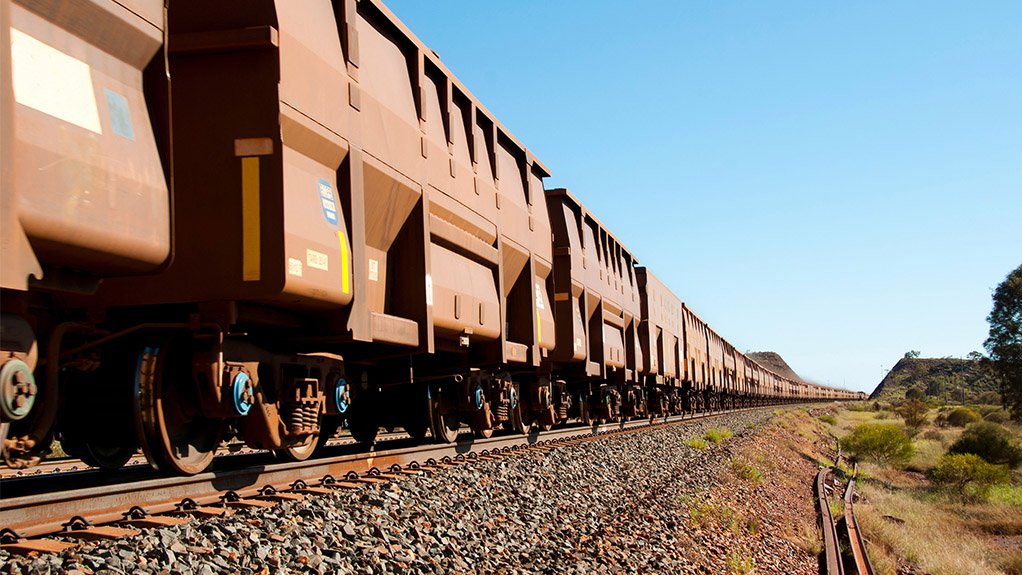Although the South African iron-ore sector showed a “healthy recovery” in 2021 and 2022 after emerging from the Covid-19-induced slump in 2020, figures have again trended downwards since 2022 following rail and port challenges, says mining industry lobby association Minerals Council South Africa economist André Lourens.
He attributes the slow recovery to major constraints impacting on South Africa’s rail and port infrastructure, which peaked in 2022, and severely affected the export of mined material.
“The continued deterioration of the rail network and inefficient ports, compounded by multiple equipment breakdowns at Saldanha Bay port – such as stacker-reclaimers, shiploaders and blocked chutes, along with adverse weather, negatively impacted iron-ore export volumes in 2023.”
Lourens stresses that despite some improvement in its performance of late, State-owned freight logistics company Transnet is unable to fully fulfil its contractual commitments to customers, owing to degraded operational performance.
The nameplate capacity of the iron-ore rail channel to Saldanha Bay is 60-million tonnes a year, yet Transnet underperformed in 2023, transporting only 56-million tonnes.
“This has prompted companies, such as global iron-ore supplier Kumba to reduce its production guidance, coupled with about nine-million tonnes of stockpiles at the Port of Saldanha reported end 2023,” highlights Lourens.
Data from national statistics provider Statistics South Africa confirms the subdued iron-ore production performance through its reporting of a decline in iron-ore production over the past two years, with levels yet to return to those recorded before the pandemic.
According to the Department of Mineral and Petroleum Resources (DMPR), South African iron-ore production in 2023 was still 12.7% lower, at 63.2-million tonnes, when compared with pre-Covid-19 levels in 2019 of 72.4-million tonnes; while sales have remained subdued.
“Sales peaked in 2021 at R121-billion, while sales in 2023 were recorded at R102.3-billion,” he says, adding that the sector has had to deal with challenging conditions over the past two years.
Lourens suggests that, by alleviating the logistical constraints on iron-ore, the sector could rapidly increase production and exports, as producers will be able to deliver product to market more efficiently.
Essentially, by removing the current bottlenecks, he says the sector can fully use its existing capacity, thereby creating growth opportunities going forward, and could serve as the catalyst to expand the domestic iron-ore sector.
Working Towards Growth
Established in June 2023, the National Logistics Crisis Committee (NLCC) in collaboration with prominent mining CEOs has aimed to stabilise and restore rail and port performance, states Lourens.
“The next step involves private-sector participation through rail line concessioning to radically improve logistics performance on the iron-ore line,” adds Lourens.
Importantly, the NLCC and various stakeholders in the mining sector plan to integrate their efforts and to support and drive rail improvement and effect logistics reform to boost their operational sustainability.
He further notes that for South Africa to fully realise the growth opportunities of its mineral potential and compete in the race for critical minerals, it needs a modern, efficient and conducive operating and regulatory environment to position itself as an investment destination of choice.
Lourens quotes the most recent data from the DMPR which reveals that, as of March this year, the iron-ore sector employed 22 651 employees, of whom about 9 680 were permanent employees, while about 12 971 were contractors.
“This sector has seen significant growth, with the workforce increasing from about 7 500 workers in 2005 to a respectable 23 762 in 2023.”
Although the South African mining sector remains globally relevant, factors, such as fluctuating demand, prices and global market conditions, will still play a crucial role in its growth.
“The goal is a competitive and growing mining industry that benefits the entirety of South African society,” concludes Lourens.
Edited by: Donna Slater
Features Deputy Editor and Chief Photographer
EMAIL THIS ARTICLE SAVE THIS ARTICLE
ARTICLE ENQUIRY
To subscribe email subscriptions@creamermedia.co.za or click here
To advertise email advertising@creamermedia.co.za or click here













